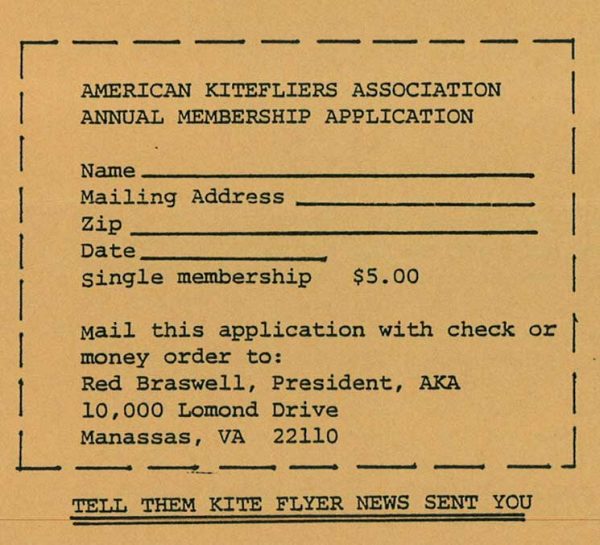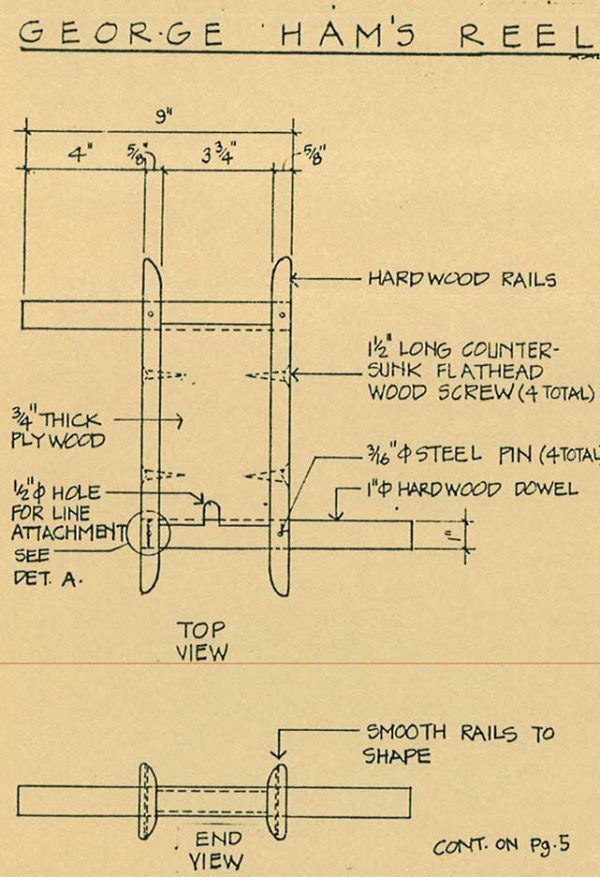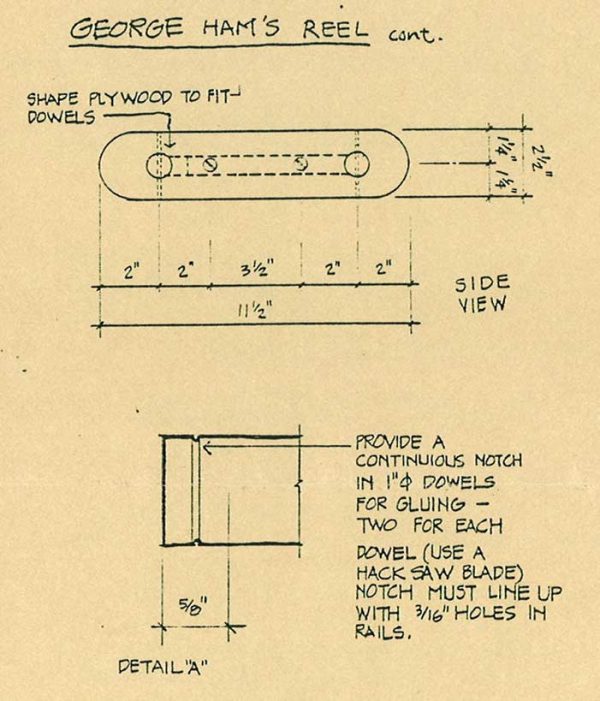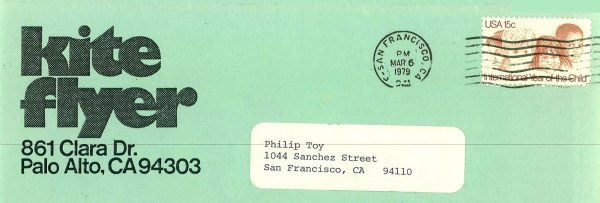Vol:2 No. 1 – July-Aug. 1979
INTERNATIONAL KITE FESTIVAL
Seattle is hosting an International Kite Festival on September 16. The Festival is being organized by a local department store and the Seattle morning newspaper in conjunction with the Washington Kitefliers Association. One of the main features will be an exhibition of kiteflying by an 8-man kite team from Shirone, Niigata Prefecture, and Tsutomu Hiroi of Tokyo, representing the Japan Kite Association. Japan Travel Bureau is organizing a Kite Festival Tour to Seattle from Tokyo.
The kite festival is part of The Orient Expressed, a 16-day festival to highlight the culture and artistry of Japan and Hong Kong. Over 230 artisans and craftspeople from the Orient plan to travel to Seattle to take part in the festivities.
The schedule of kite events starts with a free form kite flying of Japanese and Chinese design kites followed by giant kite flying of the eight man Shirone team and a team from the Washington Kitefliers Association. Competition categories with cash prizes include most beautiful, high angle; and novice kite events. A best logo category is also planned. Kites for this event are to be made of newspaper and utilize The Orient Expressed and one of the following logos. The P.I. (Seattle Post Intelligencer–the morning newspaper); The Bon (a large department store in Seattle) or The Orient Expressed caligraphy character which means “Health, Happiness and Long Life.”
Grand prize for the kite festival is a nine-foot wing span crane kite, a Coto design, imported from Japan. The grand prize winner will be determined by a random drawing of all kite participants who register for the kite competition categories.
Seattle is one of the best kiteflying cities in the United States, (according to Seattle] with more members of the American Kitefliers Association than any other city. The climate is similar to central Japan, and is usually very good in mid-September–which is also harvest time in Eastern Washington, the best time to see the farming country.
Kitefliers from all over the West Coast of the U.S. and Canada are expected to attend the kite festival, to see the 0-Dako kites from Shirone and meet other Japanese kitefliers.
WELCOME BACK KITE LINE’S
Kite Lines magazine published its latest issue last month. Throughout all the problems that the magazine has faced during the past two years and the separation of the American -Kitefliers Association from Kite Lines magazine,editor Valerie Govig has always maintained that the magazine would live and BEHOLD–it did!
Welcome Back.
If you subscribe to Kite Lines (see subscription form inclosed) you will recieve a great Annotated Kite Biblio-graphy. In my estimation the Biblio-graphy is worth the price of admission.
CLEAR TODAY, FOG TOMORROW–T. Henry
Summer weather on the Marina Green can be best be summed up by “The coldest winter I ever spent, was a summer in San Francisco,” as stated by Mark Twain. It has not been all that bad–or good–just mostly bad. The hardy kitefliers have continued to fly and participate in the summer events. Since high winds and fog has been the most common medium, a lot of low altitude and stunter kite flying has been done.
On July 4th, Raymond Lee (a 73-year-old enthusiast who makes most of his kites from bamboo and rice paper) appeared on the Green with a supply of firecrackers and incense. Mr. Lee had the program all together and the aerial display of bangs went on as a ritual event does.
All in all, the action at the Marina Green has been slow due to the inclement weather. September officially starts “real” summer in San Francisco, so most area flyers are working on new kites in anticipation of better weather to come.
Thanks to a free one pound cone of #138 polyester thread, we have managed a few completely out-of-sight flights from the Marina Green. The retrieval of the last kite flown out-of-sight was made much easier by a wandering helicopter.
Having poor weather in abundance has led me to distractions as to wondering just what to do with a ten pound bag of narrow strips of spinnaker cloth. This eventually led to a 1,160 foot tail which has been launched twice, since its creation. The first attempt was done with a J-15 para¬foil and a more successful flight was made from the rear of George Ham’s Black Bart–a J-22 parafoil. The tail wanted to attach itself around everything in sight, and with the appearance of two other kites on the Green, an early retrieval was promoted.
The kite fly of July 8th was greeted by an almost fog-free day equipped with strong winds. An otherwise routine kite—fly was greatly livened up with the appeai,ance of Sam Urner’s Hamamtsu kites. Vic Landry and Gary Hinge from San Jose arrived, bearing some new and old kite creations. Vic seems to have mastered the art of building plastic kites from the Neil Thornburn kite book. Gary briefly flew a beautiful, scale model of a Harry Saul’s barrage kite.
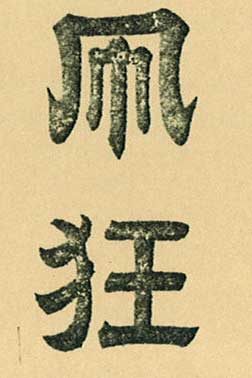 Here is a little souvenir which Sam Urner, Sacramento, Ca., brought back from Japan–a hand carved rubber stamp. It means “Tako Kiehl” or kite crazy in Japanese. Don’t forget to include it on the back side of your translated business card when traveling in Japan.
Here is a little souvenir which Sam Urner, Sacramento, Ca., brought back from Japan–a hand carved rubber stamp. It means “Tako Kiehl” or kite crazy in Japanese. Don’t forget to include it on the back side of your translated business card when traveling in Japan.
THE BASIC APPROACH… –C. Henry
If you have the ability to wander aimlessly, perhaps just around your house, and can look intelligently at your furniture, you possess the beginning quail-factions to be a kite observer. Yet, the art of being an observer of kites is not an attribute which can be acquired overnight. This skill does come a little more easier to those who already have the ability to wander about without any great ambition.
The aimless walk is essential; for kite flyers gather where there are no bleachers. After logging in many hours of kite observing, one develops a natural slat in the direction of the wind. ,Also, the face tends to form a perpetual squint and the neck stretches to a backward angle. Double chins will occur late in life as this neck muscle gradually relaxes.
The approach of the kite flyer by the observer is important. First, you must maintain a distance of about ten feet, just enough area so that the flyer can see you with his peripheral vision and is aware that he is being observed. Within seconds of this awareness, the flyer will begin pulling madly on his line in an attempt for performance or else he will mutter kite obscenities in the direction of his flying vehicle.
The observer should be attune to this action for his next movement will be based on this initial reaction to his presence.
The amount of time which elapses between the ten foot viewing area and the direct approach is important. If too much time goes by, the flyer will forget you are there and your preliminary work will have gone down the tubes. If you ap-proach too quickly, the flyer will feel that you have failed to be sincere in observing his pattern of flight. Five minutes is a safe limit to place on yourself in observing from a distance.
On the direct and final approach, make it casual but effective. Go at it from the side, amateur observers have been known to run directly into the kiter, with arms flapping and have caused fin-gers to be strung up in mid-air.
It is important to have something to comment on about the kite. “Nice kite” just will not cut the mustard. Be well versed in kite terminology. Kite idenification is essential. Beginning observers have been known to say, “Those box kites really do fly nicely,”–which is O.K. unless the kite is a parafoil.
“KITE WAR AT HAMAMTSU” –T. Henry
The film, “Kite War at Hamamtsu” was televised on the evening of the last auspicious kite fly–July 8th.
This was a very good film, in that it presented the 400-year-old festival from many angles, while moving swiftly toward the main event. Due to poor set lighting, the color was hit and miss. The narration was simple and a pleasant change from the mostly inaccurate narration these films usually receive. In short, the action as filmed spoke for itself.
The one hour episode was a real treat for me as a kite enthusiast. If you missed the show it may be of some help to write a short note to KQED, Channel 9, 500 Eighth Street, San Francisco, and ask that the film be televised again.
STILL REELING THEM IN–L.Toy
A comment on the flying line is always good–just be sure not to put it in metric terms. If the flyer gets frus-trated, he is likely to turn his back to you; which is only useful if the wind is blowing hard and you need the protection. Be sure not to put to many superlatives in your remarks.
The die-hard kite flyer will not be taken in with fancy remarks.
It has been over fifty years ago that George Ham first started making and flying kites. His first kites (as I’m sure many of us would remember) were two stick diamonds covered with newspaper. His first reel was one that his father taught him to make from some scrap wood and an old broom handle. Although George has pretty much given up on the kites with sticks, his kite reel has survived the test of time (although not unchanged) and has now evolved into a fine piece of equipment which reflects the care and craftsmanship of which we have associated with all of George’s kiting activities. George says “A hobby is something to occupy time. It’s how well you can make something–not how quick.” And it is this time and careful attention to details that we as kite enthusiasts should keep in mind when we attempt our kiting projects.
George’s reels can be used with any kite, but are especially effective with parafoils. Since they are built with a solid core they are about the safest thing to wind up a kite with, especially one with a lot of pull. George keeps several spools in his “Black Maverick’s” trunk with a variety oY lines waiting for the right time.
Here is what George recommends for flying on the following weight braided nylon line:
60 # test Delta 7′ wing span
100 # test 7-1/2 sq. ft. parafoil
200 # test 15 sq. ft. parafoil
500 # test 60 SQ. ft. parafoil
2,200 # test 200 sq. ft. parafoil
(and a monument to tie off to.)
George Ham Reel–General Notes and Construction Tips:
Materials: solid 5/8″ oak two pieces 2-1/:2″ x 11-1/2″ (George got his from a table leaf)
1″ diameter dowel – cut fOur 9″ lengths from a 3′ piece (You only need two per spool)
3/4″ plywood 3-3/4″ x 8″ both sides veneered
4 [four} 1-1/2″ long flat head wood screws
4-3/16″ steel pins, 2″ long (they can be cut from large nails) White glue and wood putty Sandpaper #80, #150, #220 grits Sandpaper cloth #400 wet/dry Varithane
“Semichrome” paste polish
Shape all pieces as indicated on plans. Sand each piece starting with the 80# grit sandpaper and work your way to the 220#.
Drill the holes in the rails for the 3/16″ diameter pins.
Notch the dowel handle making sure the holes in the rails line up with the notches on the dowels. Cut a hole in the plywood for the line attachment. Shape the plywood to fit into the wood dowel (final shaping can be done with putting sand¬aper around the dowel.) Glue the reel together and force glue down the 3/16″ hole until it comes out the other end. Allow it to dry overnight.
Drill four holes for the wood screws countersinking them and filling the holes with putty. Drill out the 3/16″ holes for the pins and glue them, setting them below the wood surface and filling with wood putty. Now you’re ready to start finishing the reel.
First you should raise the grain three times with a light sanding with #220 sandpaper inbetween. (To raise the grain use a damp sponge to dampen the reel and then quickly dry the reel over an open flame. (It helps if you’re cooking with gas!!!) Apply 4 coats of varithane with a light sanding inbetween using the #400 wet/dry cloth and finally polishing with the “semichromepaste polish (or use a good cal, wax) attach your line through the hole with two half hitches and three overhand knots and voia’la you’re ready to fly.
HI-TECH AND HIGH DENSITY POLYETHYLENE–L. Toy
For those of you into plastic bag kite ma-terial, high density polyethylene is one of the most advanced products on the plas¬tic market. It has twice the strength of regular polyethylene film–along with a greater stretch resistance making it a great material to cover kites with. You may have known about its existance but not know what it was. In some supermarkets the vegetable and fruit bags that have .a milky appearance and sound like cellophane when crinkeled are made of high density polytethylene film.
Jack Van Gilder uses it on his kite train; he says it’s easy to heat seal if you use a sheet of wax paper for a pressing cloth between the soldering iron and the plastic. I have tried this technique and it really works well on some two mil thick material I have. I have not had much luck in finding any source of the material but it is available in bag form. Jack wrote to tell me that the Great Winds Kite Store in Seattle had some bags but we have not had word from them as of yet.
THINGS SEEN BUT NOT FORGOTTEN–L.Toy
It was during a recent visit by Takeshi Nishibayashi that I was first introduced to the Japanese kite reel (see sketch). Nishi flew most of the smaller kites he had with him from two spools of similar design, with one being slightly larger in size.
The spools held several hundred yards of thin cotton or linen thread. Nishi uses a tiller hitch to attach to the kite bridle and I saw no sign of any fishing swivels such as we use here. (The tiller hitch is one knot that is easily untied, at least on natural line).

What was most fascinating to watch was how Nishi, always in control, would manipulate the spool–either letting line out or bringing it in. He wore a pair of light cotton gloves which would allow the spool to rotate freely in his grip. There were two ways in which he would let out line: either off the end (which would induce twist into the line) or perpendicular to -die reel’s axis. (This was done by holding one of the reel’s top pegs and the handle on a horizontal axis and spinning it or by just letting the kite take out the line by its own force.) Sometimes he would pull the reel back as if hauling in a big fish and then toss the line out like a fly fisherman, all the while smiling and watching his kite respond to his silent but definite commands.
To bring a kite in he would simply reverse the spinning procedure always keeping one eye on the kite and one eye on the spool. This seems to work quite well,but then again, Nishi knew what he was doing.
A CHALLENGE TO KITE PEOPLE–P. Walker
During the past several years an interesting phenomenon has taken place in France, England, the United Stated and in the San Francisco Bay Area. This phenomenon has been the fantastic resurgence of kites, kite flying and all the allied publications and interest. Several people rode the crest of this wave of success and started lucrative kite businesses. Some scientists devised incredible! kites and alied paraphernalia.
More recently a new phenomenon in kite flying has taken place. Many of the publications and organizations that rode high during the ‘kite years’ fell on hard times. Nothing can stay “hot” forever. With this decline in kite interest came some problems but also some opportunities.
The problems, of course, were mostly lack of support both financial and moral. The oppor-tunities are more subtle but perhaps most important. Those of us that are left with an interest in kites carry more weight with our activities and our opinions. WE CAN MAKE A DIFFERENCE IF WE PARTICIPATE.
AND SO THE CHALLENGE : Nationally we have two groups of people that are really interested to know what they can do to satisfy your every kite related wish. Valerie Govig, editor of Kite Lines magazine and Red Braswell President of the American Kitefliers Association both are anxious to fulfill your kite needs but they cannot guess what you want unless you PARTICIPATE and write to them your interest and even your demands. If you don’t like something, let them know. If you want something, let them know and don’t forget if you like something, let them know that too. A few strokes from a subscriber go a long way.
TO FURTHUR CHALLENGE : Locally you have us, Tom, Carol, Lee and myself of Kite-flyer News that also want to do an out-standing job for all of you.
With this issue of Kiteflyer News we celebrate a year of publication.
During that year the response to the newsletter has been gratifying in that you continue to support us with your subscriptions. On the other hand response to our requests and pleas for imput have largly gone unheeded.
Partially this lack of participation is your fault – you did not sit down and write that note to us when you wanted to see something different done with YOUR newsletter. Partially the lack of participation is our fault. It is hard to relate to a newsletter that you subscribe to. You probably haven’t written your local newspaper to tell them what you want them to publish either. To cure this problem of communication we feel mature enough as an organization to become just that—an organization or club. This will accomplish several goals for all of us–more PARTICIPATION in a wider range of fun and respon-sibility. As a club that publishes a newsletter we will have a slate of officers that will guide us in the direction that all of us as members will share in choosing. As a club we will publish a newsletter that will follow that direction and be more responsive to the entire group. As a club more democratic decisions will be made how to spend and raise money. All of us will benefit.
Your next issue of Kiteflyer News (September 1979) will contain ballots for you to fill out to choose a club name and officers. First however, we need you to nominate people who you think would be appropriate to fill the following offices:
President
Vice President
Corresponding Secretary
Treasurer Newsletter Editor
We also will need to vote for a club name that you like so nominate a name too.
To make it easier for you to PARTICIPATE, use the pre-stamped (we were flush) nominating postcard enclosed to make your initial choices.
Finally we will not force anyone to become an officer–we want them to want the job–so don’t hold back from nominating someone. We will check with them as soon as all the nominating cards are in.
If the wind blows lightly throughout the day, it sets a vast body of air in motion over a wide area. The cause,of course is convection created by the steadily rising daytime temperature. When the sun sets the convection declines steadily and for a period of time before dark the wind
at ground level, particularly in areas where there are many obstacles such as low hills, buildings, trees and various causes of ground friction affecting the airflow, the movement virtually ceases.
The body of air aloft, neverheless, has been set in motion and continues on for hours into the night. In order for your kite to fly on this moving stream of air, however, you have to ‘get it up where the action is We all look forward to PARTICIPATING with you in the changes and activities that will enable Kiteflyer News to celebrate many more Happy Birthdays.
KITE FLYER NEWS is pleased to include the following article, “Flying In the No Wind” by Bob Ingraham. Bob Ingraham is one of the founders of the American Kitefliers Association, served as a past president of the A.K.A. , was publisher and editor of Kite Tales, and is still a very active part of the kite flying scene.
FLYING IN THE NO WIND–Bob Ingraham
This is where the high start or running launch is important.
A high start can be accomplished in two ways. It is best to place your kite as far away as possible–propping it up at a comfortable angle against a tree, post or some upright structure such as a fence. Two or three hundred feet distance from the reel is a good recomendation. Making certain the line is free of any possible snag, pull up firmly and start a short but vigorous run. If your kite is a good climber it will go up amazingly fast. Depending upon your physical condition, you can create a wind from 6 to 9 m.p.h.
As it is necessary to have some wind blowing in order to fly a kite, it is assumed by most non-kiters and not a few regular kitefliers that a considerable amount of wind is required to loft any kite.
However, veteran kiters, after years of experience, learn that not nearly so much wind is required if you understand the peculiarities of moving air.
A lot of good kiteflying time has been lost and more will be while kitefliers sit around, fretting and fuming because they think the wind isn’t blowing at all or blowing so lightly that a trip afield would be futile. ‘Taint so.
As soon as you reach the limit of your run, turn quickly and man your kite, If it appears hesitant, see if it will fall back. If so, that indicates some wind at the level it has reached. If it falls back, let it go for a short distance then do a couple or three pull-ups. Then repeat the procedure until the kite begins to climb on its own. It is now in the tidal movement of air and can stay up for hours.
Of course this is recommended only for light and soaring types of kites. Those with fast sink rates won’t make it. The alternate method to this high start running launch is to get some easy going friend to carry the kite out to the launch spot. Or, if you are fat and forty, maybe he will do the running.
An example: On the evening of the most recent 4th of July, when the sun had set and there was no movement of wind perceptible on the ground, I high-started a large delta carrying a 3/4 ounce flashlight. It caught the tidal wind flow at about 300 feet, went to about 1,200 feet and flew steadily in one spot for nearly three hours; winking its tiny light for the whole world to see.
On bringing it in it flew firmly all the way down to about 300 feet when the bottom dropped out of the wind it was flying in and it went into a long glide right down to our feet. Try it sometime. There’s usually a wind blowing way up yar somewhar.
Dinesh Bahadur of Come Fly a Kite and KGO radio are combining efforts to once again bring the Bay Area a kite bash as only Bahadur can do. This years bash will be held at the Polo Field in Golden Gate Park, Sunday August 5th from noon to 4:30 pm.
Those of you who have participated or watched (a kite type of participation its-self) one of the festivals or events that Dinesh has been responsible for need no further explanation For those of you new to this particular type of exciting madness, be prepared for thousands of people, lots and lots of kites with emphasis on kite fighting. Usually a great crazy day.
This years event will feature ten kite fighting experts from eight countries.
One new twist this year will be a pri7e aivern.bywilkes Bashford clothiers for the Best Dressed Kite. On of . Wilkes most prominent customers in the person of Willie Brown will join the fun on the 5th.
As always Kiteflyer News will be represented by the faithful. Look for our ‘A’ frame sign board and banners or, look for a familiar kite.
One nice thing about not sponsoring this event is that we can fly kites to our hearts content.
See you there.
By way of standard reference–KITE FLYER NEWS is available six times a year (weather permitting) at the minimal cost of a trip to Doggie Diner–$5.00 a shot. Send all money, trading stamps or gold bars to 861 Clara Drive, Palo Alto, CA 94303.



